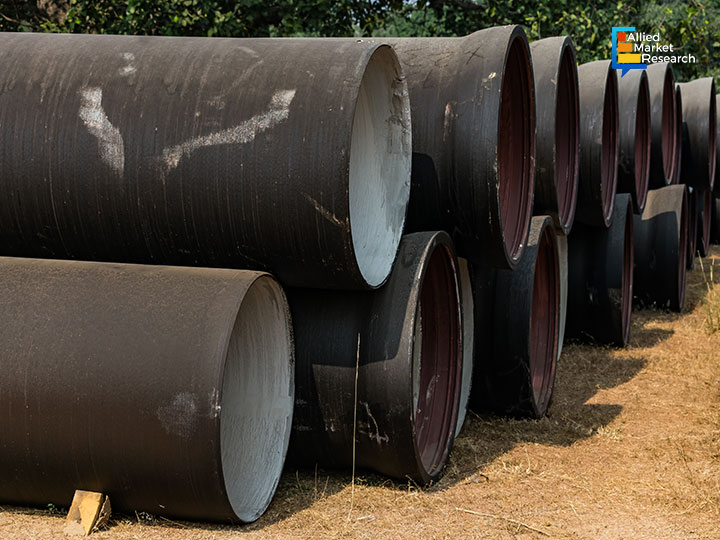How Ductile Iron Pipes Reinforce Long-Lasting Green Infrastructure

26 Jun
2025
Highlights:
-
Evolving joint systems in ductile iron pipelines
-
Role of ductile iron pipes in powering modern infrastructure
-
Promising partnerships of key players in the sector
Ductile iron pipes act as a key element in modern water and wastewater infrastructure, due to their outstanding strength, durability, and adaptability. They are made from ductile iron, a strong and versatile material known for greater corrosion resistance. They are commonly used for water and sewer pipelines due to their ability to withstand high pressure, impact, and soil movement. Ductile iron is a type of cast iron where the graphite within the iron is in a nodular form, making it more flexible and less brittle than traditional cast iron.
Innovations in ductile iron pipe joint technology
Ductile iron pipe joints are as important as the pipes themselves, determining the integrity, flexibility, and longevity of the pipeline system. Over recent years, joint technology has evolved to offer greater flexibility, ease of installation, and resistance to dynamic stresses, making ductile iron pipes suitable for a broader range of environmental and operational conditions.
Push-on joints are the most widely used and straightforward type for underground ductile iron pipe installations, enabling rapid assembly by inserting the spigot end of one pipe into the bell end of another, secured with a rubber gasket for a tight seal. Innovations like the FASTITE® and TYTON® systems incorporate integrally cast gasket recesses for enhanced sealing and allow joint deflection up to 5° and occasionally 15° for larger pipes, helping pipelines navigate bends. This reliability makes push-on joints a preferred choice for urban water pipelines, thereby creating wider opportunities for the ductile iron pipes industry.
Moreover, restrained joints are engineered to prevent pipe separation caused by high pressure or thrust forces, making them helpful for challenging installations such as penstocks, river crossings, and zones with notable ground movement. Modern innovations in restrained push-on joints utilize deeper bells alongside specially designed locking wedges or rings to securely lock pipes together, removing the necessity for thrust blocks and lowering installation expenses. These features make restrained joints ideal for high-pressure water transmission lines and subaqueous applications, ensuring robust and dependable performance.
Rise of ductile iron pipes in urban and industrial systems
The versatility of ductile iron pipes, powered by advances in jointing technology, is expanding their use across diverse sectors. Urban growth and the need for leak-free water systems are prompting cities to replace old pipelines, supported by U.S. EPA Drinking Water State Revolving Fund programs.
The industrial sector increasingly relies on ductile iron for process piping in power plants, chemical facilities, and oil & gas operations. Gas distribution networks, especially in earthquake-prone areas, benefit from the strength and secure joints of these pipes. Subaqueous and trenchless installations, such as underwater crossings and urban rehabilitation, utilize advanced joint types for minimal environmental impact and rapid deployment. In addition, the growing demand for sustainable infrastructure is promoting ductile iron pipes for their recyclability and long service life.
PNP Supply and Demaclenko merged to meet rising demand for TRM pipes
In Sempember 2024, PNP Supply partnered with Demaclenko to enhance the North American distribution of TRM (Tiroler Rohre GmbH) ductile-iron pipes, widely used in snowmaking systems. Through this partnership, PNP supply aimed to expand its market reach and support by meeting the increasind demand for TRM’s high-pressure ductile-iron products across the nation. In addition, Demaclenko has planned to offer ski areas complete piping systems, fittings, snow guns, and snowmaking construction services.
Final thoughts
Ductile iron pipes play a key role in modern piping solutions, offering wider applications across municipal, industrial, and environmental sectors. Moreover, advancements in joint technology have enhanced diverse use cases of these pipes in urban systems and industrial pipelines. These advances also ensure reliable performance, cost efficiency, and sustainability in meeting the evolving demands of modern infrastructure development.
To know more about the expanding applications of ductile iron pipes, reach out to our industry analysts today!

Rosy Behera
Author's Bio- Rosy Behera holds a bachelor’s degree in Electrical and Electronics Engineering and now she is a content writer by profession. She loves to portray her thoughts and ideas with a nice command of words. Grabbing an audience with her creative write-ups is one of her biggest assets so far. Apart from writing, she is a certified “Odisi” dancer and has done Gardharva in Drawing, Painting, and Arts. She always explores new things through travel and is a big foodie.
Avenue: Entire Library membership of Allied Market Research Reports at your disposal
- Avenue is an innovative subscription-based online report database.
- Avail an online access to the entire library of syndicated reports on more than 2,000 niche industries and company profiles on more than 12,000 firms across 11 domains.
- A cost-effective model tailored for entrepreneurs, investors, and students & researchers at universities.
- Request customizations, suggest new reports, and avail analyst support as per your requirements.
- Get an access to the library of reports at any time from any device and anywhere.
Related Post
-
How are Submarine Cables Transforming Global Connectivity with Enhanced User Experience?
-
Endoscopy Procedures: Transformations in Techniques and Applications
-
AI-Powered Video Analytics: How the Product Actually Works for enterprises
-
Painting Robots: Transforming Precision Coating and Creative Applications
-
Innovations in Pharmacovigilance Systems Advancing Patient Safety
-
Understanding Edge Security: Keeping Data Safe Near the Source
-
Exploring the Use and Advancements of 3D Laser Scanners in Professional Applications
-
Reinforcing Industrial Controls with Smarter Tools and Training








